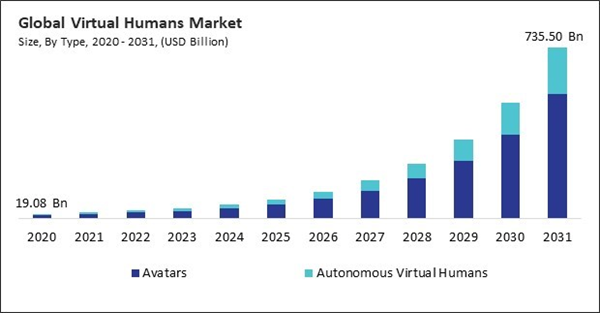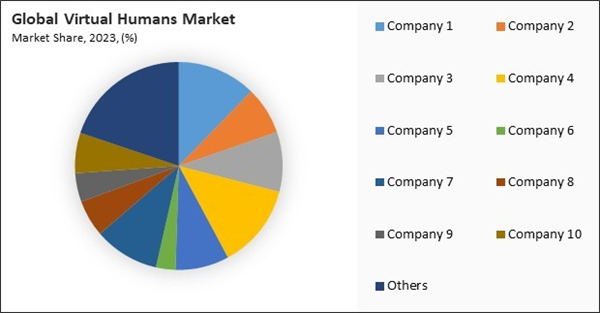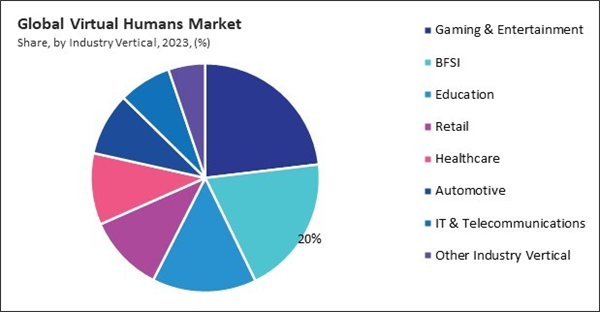The increasing demand for realistic avatars and interactive experiences in gaming and virtual worlds continues to drive the growth of this segment, with advancements in animation, artificial intelligence (AI), and graphics technology making these virtual humans more lifelike and interactive. Additionally, the gaming & entertainment segment recorded nearly 1/4threvenue share in the market in 2023. Virtual humans play a crucial role in creating immersive experiences within the gaming and entertainment sectors. Their use extends to video games, virtual reality (VR) environments, and interactive storytelling, enhancing user engagement with lifelike avatars and dynamic narratives.
The growing demand for virtual human-driven customer service aligns with the rise of omnichannel communication. Virtual humans can seamlessly interact across multiple channels, including websites, mobile apps, and social media platforms, providing consistent and coherent support. This multi-channel presence helps businesses maintain customer engagement and enhance their overall customer experience, driving further adoption of virtual human technologies. Additionally, Startups also play a pivotal role by introducing innovative concepts and applications of virtual humans. The competition between large corporations and startups fosters a culture of innovation, leading to rapid advancements in the field. As this digital transformation unfolds, virtual humans are set to be increasingly integrated into various sectors, such as healthcare, customer support, and entertainment, making them more accessible and functional for different applications. Hence, increasing demand for realistic digital interaction in customer service and support and increased investment in digital transformation worldwide from tech giants and startups is driving the market's growth.
However, the maintenance costs are not just limited to infrastructure but also encompass the ongoing development of the technology to ensure it remains relevant. Virtual humans must continually evolve to meet new demands, maintain customer engagement, and address emerging security, privacy, and AI ethics challenges. These costs may deter some businesses from fully investing in virtual humans, slowing the market’s growth. Thus, high development and maintenance costs associated with realistic and advanced virtual humans hamper the market's growth.
The leading players in the market are competing with diverse innovative offerings to remain competitive in the market. The above illustration shows the percentage of revenue shared by some of the leading companies in the market. The leading players of the market are adopting various strategies in order to cater demand coming from the different industries. The key developmental strategies in the market are Acquisitions, and Partnerships & Collaborations.
Driving and Restraining Factors
Drivers
- Increasing Demand for Realistic Digital Interaction in Customer Service and Support
- Growing Popularity of Virtual Humans in Entertainment, Media, and Video Games
- Increased Investment in Digital Transformation Worldwide from Tech Giants and Startups
Restraints
- High Development and Maintenance Costs Associated with Realistic and Advanced Virtual Humans
- Concerns Over Data Privacy and Security in Virtual Human Interactions with Sensitive Information
Opportunities
- Rising Popularity of Virtual Humans as Brand Ambassadors and Digital Influencers
- Corporate Training and Leadership Development through Virtual Human Facilitators
Challenges
- Competing with Human Interaction Preferences in Sectors That Rely on Emotional Intelligence
- Ensuring High-Quality, Realistic Animation and Speech Synthesis Without Exorbitant Costs
Avatars Outlook
The avatars segment is further subdivided into interactive digital human avatar and non-interactive digital human avatar. In 2023, the interactive digital human avatar segment attained 53% revenue share in the market. Interactive digital human avatars are designed to engage and interact with users in real-time, responding to inputs such as voice, gestures, and actions. These avatars are commonly used in applications like virtual customer service, gaming, training simulations, and live virtual events. Their ability to create personalized, dynamic experiences has made them highly popular, particularly as businesses seek more engaging and immersive interactions with customers and audiences. The growing demand for virtual assistants, interactive digital marketing, and customer support has contributed significantly to the success of interactive avatars.Industry Vertical Outlook
On the basis of industry vertical, the market is segmented into gaming & entertainment, BFSI, education, retail, healthcare, automotive, IT & telecommunications, and others. The education segment procured 15% revenue share in the market in 2023. Virtual humans are increasingly used in educational settings to provide personalized learning experiences, virtual tutoring, and interactive simulations. These avatars can engage students in ways that traditional methods cannot, offering customized instruction, virtual labs, and immersive learning environments. The growing trend of online learning and the increasing adoption of EdTech tools are fueling the demand for virtual humans to improve student engagement, participation, and learning outcomes.Type Outlook
Based on type, the market is divided into avatars and autonomous virtual humans. The autonomous virtual humans segment held 26% revenue share in the market in 2023. These virtual humans go beyond avatars by being capable of independent decision-making and interaction with users in a lifelike, intelligent manner. They are powered by artificial intelligence (AI) and machine learning, enabling them to respond dynamically to various inputs. This segment is growing, especially in industries like customer service, healthcare, and entertainment, where autonomous virtual humans are being used for tasks such as virtual assistants, interactive storytelling, and more personalized user experiences. The continued development of AI technology is expected to drive further growth in this segment.Regional Outlook
Region-wise, the market is analyzed across North America, Europe, Asia Pacific, and LAMEA. The North America region witnessed 40% revenue share in the market in 2023. This market dominance can be attributed to the strong presence of technology-driven industries, especially in the gaming, entertainment, BFSI, and education sectors. North America has seen significant investments in artificial intelligence (AI) and virtual reality (VR) technologies, facilitating the development of highly interactive and lifelike virtual humans. Additionally, the region’s high adoption of digital solutions and advanced infrastructure has made it a key hub for innovations in virtual human technologies, driving their widespread application across multiple industries.List of Key Companies Profiled
- Epic Games, Inc.
- Alibaba Cloud (Alibaba Group Holding Limited)
- Unity Software Inc.
- Meta Platforms, Inc.
- Google LLC (Alphabet Inc.)
- IBM Corporation
- Microsoft Corporation
- Amazon Web Services, Inc. (Amazon.com, Inc.)
- Apple Inc.
- NVIDIA Corporation
Market Report Segmentation
By Type
- Avatars
- Autonomous Virtual Humans
By Industry Vertical
- Gaming & Entertainment
- BFSI
- Education
- Retail
- Healthcare
- Automotive
- IT & Telecommunications
- Other Industry Vertical
By Geography
- North America
- US
- Canada
- Mexico
- Rest of North America
- Europe
- Germany
- UK
- France
- Russia
- Spain
- Italy
- Rest of Europe
- Asia Pacific
- China
- Japan
- India
- South Korea
- Australia
- Malaysia
- Rest of Asia Pacific
- LAMEA
- Brazil
- Argentina
- UAE
- Saudi Arabia
- South Africa
- Nigeria
- Rest of LAMEA
Table of Contents
Companies Mentioned
- Epic Games, Inc.
- Alibaba Cloud (Alibaba Group Holding Limited)
- Unity Software Inc.
- Meta Platforms, Inc.
- Google LLC (Alphabet Inc.)
- IBM Corporation
- Microsoft Corporation
- Amazon Web Services, Inc. (Amazon.com, Inc.)
- Apple Inc.
- NVIDIA Corporation
Methodology

LOADING...










